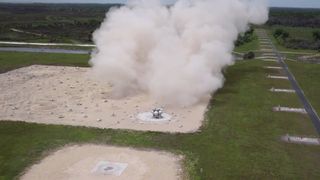NASA's Morpheus Lander Prototype Touches Down on Mock Moonscape (Video)
A prototype of NASA's Morpheus lander kicked up a cloud of fake moon dust as it touched down softly on a mock lunar landscape in Florida in this week.
On Wednesday (April 30), the Morpheus vehicle dubbed Bravo lifted off for its twelfth free-flight test at NASA's Kennedy Space Center. The robotic vehicle flew a pre-programmed path that launched it vertically, and then rose to an altitude of more than 800 feet (243 meters), NASA officials said in a description of a video of the mock moonscape flight.
After liftoff, Morpheus then flew sideways 1,300 feet (396 m), hovering over a 65-yard (59 m) square sandbox full of obstacles like rocks and craters. [Photos: NASA's Project Morpheus Robot Lander]

NASA recently started testing its automated landing and hazard avoidance technology (ALHAT) installed on the vehicle. This 400-pound suite of computers and three instruments is designed to scan the surface of a potential landing site for hazards, such as a dangerous boulder or crater, so that the spacecraft doesn't crash or tip over as it touches down.
The ALHAT technology mapped the square and identified a safe landing site 4.5 feet (1.4 m) east of the center of the landing pad and targeted that location to gently touch down on the mock lunar surface, NASA officials said.
"We've been working a long time, eight years, to prove we can do autonomous, precision landing and hazard avoidance and guidance," Chirold Epp, project manager for ALHAT, said in a NASA statement a week before the latest flight. "We really need to show the world that everything we've been advertising for eight years works."
The Morpheus project suffered a spectacular setback in August 2012, when the lander prototype crashed and exploded just moments after liftoff in its first free flight. But the latest round of Morpheus' free-flight tests, which began on Dec. 10, 2013, has been successful so far.
Get the Space.com Newsletter
Breaking space news, the latest updates on rocket launches, skywatching events and more!
Morpheus is an autonomous vertical takeoff/vertical landing vehicle intended to fly to the moon with up to a 1,100-lb. (500 kilograms) payload, perhaps consisting of a humanoid robot, a rover or a fuel lab, NASA officials say. With modifications to its landing system, the spacecraft possibly could be used to deliver cargo to other planetary bodies, such as an asteroid in deep space.
The Morpheus lander uses liquid oxygen and methane, or so-called green propellants, which NASA officials say are safer and cheaper to use than traditional rocket fuels because they can be stored in space for longer periods.
Follow Megan Gannon on Twitter and Google+. Follow us @SPACEdotcom, Facebook or Google+. Originally published on Space.com.
Join our Space Forums to keep talking space on the latest missions, night sky and more! And if you have a news tip, correction or comment, let us know at: community@space.com.

Megan has been writing for Live Science and Space.com since 2012. Her interests range from archaeology to space exploration, and she has a bachelor's degree in English and art history from New York University. Megan spent two years as a reporter on the national desk at NewsCore. She has watched dinosaur auctions, witnessed rocket launches, licked ancient pottery sherds in Cyprus and flown in zero gravity on a Zero Gravity Corp. to follow students sparking weightless fires for science. Follow her on Twitter for her latest project.